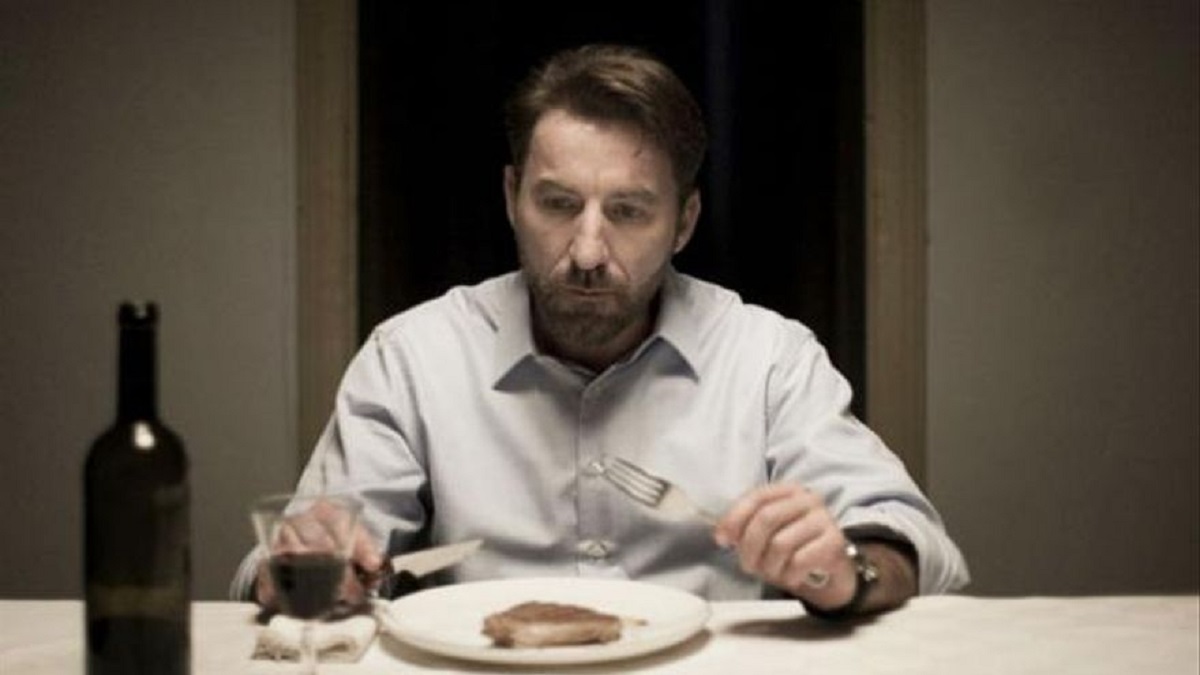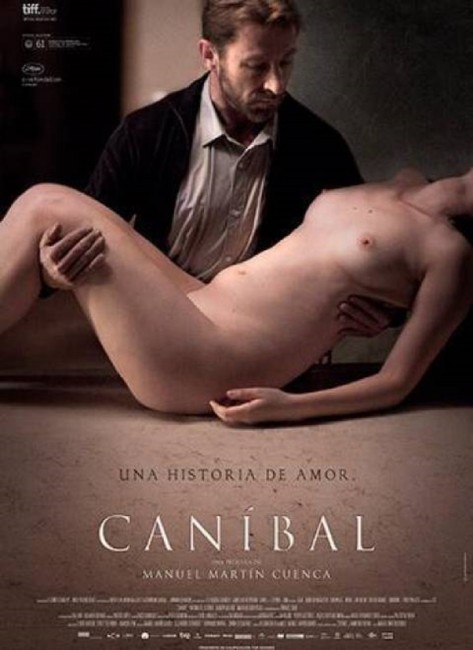(Canibal)
Crew
Director – Manuel Martin Cuenca, Screenplay – Manuel Martin Cuenca & Alejandro Hernandez, Based on the Novel by Humberto Arenal, Producers – Fernando Bovaira, Manuel Martin Cuenca, Simon De Santiago & Alejandro Hernandez, Photography – Pau Esteve Birba, Visual Effects Supervisor – Curro Muñoz, Production Design – Isabel Vinuales. Production Company – La Loma Blanca P.C./MOD Producciones/Libra Film/CTB Film Company/Luminor/TVE/Canal Sur Television/Canal+/AXN/Junta de Andalucia.
Cast
Antonio de la Torre (Carlos), Olimpia Melinte (Alexandra/Nina), Maria Alfonso Rosso (Aurora)
Plot
Carlos is a tailor in Granada who lives by himself and avoids involvement with others. He is also a serial killer who abducts women he desires, kills them and eats their flesh. Despite himself, he is drawn in to befriend Alexandra, a Romanian masseuse who moves into the apartment above his. Carlos tries to remain uninvolved as she comes begging his help following a fight with her boyfriend. He offers to drive her to the police station. Some days later, Alexandra’s sister Nina comes looking for Alexandra who has disappeared. Carlos offers Nina help and becomes drawn in by her. Despite himself, he forms an attachment to Nina as she starts to become attracted to him.
Cannibal is a film from Spanish director Manuel Martin Cuenca. It should be noted – and this is important when it comes to the film’s approach to genre subject – that Cuenca’s background as a director was first in documentary and then in non-genre dramas such as The Weakness of the Bolshevik (2003), Hard Times (2005), Half of Oscar (2010) and the subsequent The Author/The Motive (2017) and The Daughter (2021), all of which found their audiences in international festival play.
Manuel Martin Cuenca astonishes you with the cool, detached understatement he demonstrates in the opening scenes. The credits play out on a very wide-angle that takes place at night with the lit-up forecourt of a gas station in the centre of the shot as we watch a couple as they mill around and get back into their car and depart, before a car window winds up in the foreground and we realise that someone has been secretly observing the whole scene, whereupon the still unseen observer starts his car and follows the couple. We then switch to the inside of the car of the couple as the stalking driver passes them and then a moment later abruptly turns and reverses at speed back towards them. Cuenca then cuts to another wide angle as the couple’s car is crashed off the side of the road and the mystery driver’s vehicle just sits parked there idling, before we move into closer shots as Antonio de la Torre exits, goes down to the crashed car and returns dragging the woman’s body.
We then cut to extreme wide-angles following his vehicle up through the mountains as dawn starts to rise, before he arrives at his mountaintop cabin. Inside, we see him calmly stripping the body and tying the unconscious woman’s wrists to a table. We then see him taking butcher’s implements from the wall and move in to a closeup on her legs as we hear the sound of cutting and see a trail of blood run down the drain of the table into a pan. The film then cuts to Antonio de la Torre returning to his apartment in the city and nonchalantly placing several wrapped slabs of meat into his freezer. These scenes presage exciting things for the film to follow.
The cold obliqueness of the set-up, which tells us everything we need to know about the character, his stalking and the methodical coolness of his butchery, all without a single line of dialogue in twelve minutes, is astonishing. Not to mention is almost the complete opposite of everything we expect from a genre film or a work entitled Cannibal. Any easy expectations of a horror film – that Manuel Martin Cuenca is going to do something to shock us or pull standard suspense set ups – quickly go out the window. It becomes a film of silences where everything takes place in slowness and quietude.

On the other hand, such an astonishing opening leaves you constantly expecting that something even more out there is going to happen. After Antonio de la Torre returns home, the film segues into a series of much quieter scenes that pit his unobtrusive, impassive personality up against the breezy energy of Olimpia Melinte (which is all offset by the secrets we know he is holding). There is such a strong contrast between the two opposites that it becomes an abrupt disconnect when she suddenly disappears off stage.
Alas, the film that up until then has been slow-building simply becomes one that is slow and uneventful. The plot becomes more than an hour’s worth of drawn-out drama centred around the issue of what happened to Alexandra – and the question that looms unspoken of whether he ate her or not? – and then of the budding attraction that seems to grow between he and her sister Nina (also played by Olimpia Melinte) where we seem to go through about the same length of time wondering if he is going to kill and eat her too.
Cuenca does punctuate the set-up with one scene – a less effective variant on the opening scene – where de la Torre follows a couple to the beach (where, as we first see him spy on them, we are unnerved by the woman’s resemblance to Alexandra), where the couple go skinny-dipping, de la Torre sneaks into and takes their car, the man runs up the dunes only to promptly be rammed by the car and de la Torre then comes down to the beach to wait for the woman to come out of the water, waiting as the light passes from day until night, before she chooses to swim out into the ocean to what we later learn is her death.
Cannibal does eventually resolve itself in unusual and interesting ways [PLOT SPOILERS]. Typical of Manuel Martin Cuenca’s background as an arts director as opposed to a horror director, this comes in simple confrontation between characters, not in terms of the expected scenes of Antonio de la Torre pursuing Olimpia Melinte with a knife or any such. He takes her to the mountain cabin, we cut from her curled up in bed before the fire to he placing her naked body on his slab. However, Cuenca then disorientingly cuts from what we expect to be her death to her waking up in bed in the morning. This segues into a dramatically powerful scene where he explains what he is to her and how he killed her sister but couldn’t kill her because he discovered feelings for her, followed by her shocked and upset reactions. The final scene, which again plays against expectations, is an unexpectedly oddly tender one.

